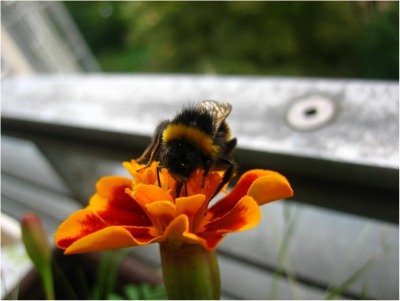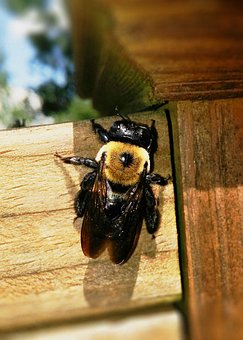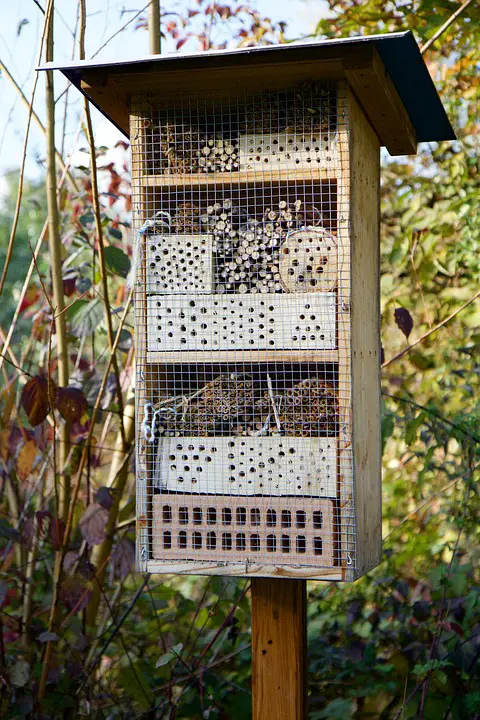
Search Wild Foods Home Garden & Nature's Restaurant Websites:
Wanna Build a Bee House?
By: Pauline Vanderwerf
Last summer the big “buzz” was solitary bee houses and we were all encouraged to do our part to help the bee population. Bee house kits and completed houses were everywhere. I saw these late in the summer and thought, hey... I’ll do my part and make one in the spring.
So I have spent the last few weeks searching the Internet for plans to build one on my own and have come across tons out there... and tons of information as well. All along, I’ve been thinking that I would be building a pretty little bee house to sit in my garden where it would look cool and solitary bees can get out of the rain and sleep at night.. how quaint. But these bee houses are actually nests to hatch our future solitary bee population! OK, probably most of you already knew that, but it was a revelation to me.
Great care must be taken to ensure that these little hatcheries are built properly or they will invite disease, pests, and predators. Instead of building beautiful little bee houses, you could be building bee tombs or even worse, an all you can eat buffet for woodpeckers. I started out with all good intentions of writing an article on building a bee house, using pictures documenting my own process, but I have been so humbled by what I didn’t know about solitary bees, that I thought I would better serve sharing what little I do know.

Bumble Bee (Public Domain Image)
The life of a Solitary Bee
So... lets start off with some basic information about the solitary bee life. Life cycle timing varies from species to species, but the process is similar for them all.
Solitary bees emerge from their overwintering cocoon in the spring. The males emerge first and begin to forage for nectar. The females emerge after the males, will seek them out, mate, then forage for nectar and pollen. The males expire after the mating is complete.
The fertile female will then choose a nesting site and begin stocking her nest with a supply of food for each egg she will lay. A Female solitary bee can deposit between 4 and 30 eggs into her nesting tunnel during her six to eight week adult life cycle. She can choose which sex to create, and will lay the female eggs at the back of the tube and the male eggs at the front as the males will hatch and emerge first.
She places a ball of pollen inside the cell and lays an egg on top, leaving space for the larvae to grow into an adult bee. She builds a partition wall and repeats the process until the whole tube is filled, leaving a space at the entrance of the tube empty before closing it off and moving on to another tube.
After consuming the food stores left by by its parent, the larva then spins a cocoon around itself. It will metamorphoses into an adult bee and remain dormant until the following spring, when it will repeat the cycle again.
There are a lot of different species of solitary bees in North America. They vary in size and appearance and where they nest. Roughly 70% build their nests in underground burrows. The rest build their nests in cavities, and those are the ones that will hopefully use our bee houses successfully.

Carpenter Bee (Public Domain Image)
Why are they so Special?
Solitary bees don’t have pollen baskets, so each time they visit a flower they lose more pollen than hive bees, making them better pollinators. A single red mason bee is equivalent to 120 worker honeybees in the pollination it provides! Solitary bees are non-aggressive and do not swarm, so they are safe and pleasant to have around. I know I have spent some late afternoons weeding my flower bed and the flowers will be covered with all kinds of different looking bees, and they are all oblivious to my poking around them. They just carry on doing their polleny thing.
,_Sandy,_Bedfordshire_(8732962778).jpg)
Male red mason bee (Osmia bicornis), Sandy, Bedfordshire (By: Orangeaurochs from Sandy, Bedfordshire, United Kingdom Attribution 2.0 Generic)
A few years ago we had carpenter bees eating away at our back porch roof. We would sit out there in the early evening and a shower of chewed up wood would sprinkle down. You could actually hear the crunch, crunch, crunch of their chewing. Now, I love carpenter bees. They’re about the size of a bumble bee and make a great loud buzzing as they bumble around. A distinctive shiny black circle on their back makes them easy to identify.
As much as I love them, I couldn’t let them eat our patio roof. I did a little research and found that the best way to get rid of them was to just paint the surface that they are eating... they only like raw wood. So, we waited until the following spring, painted the the underside of the roof and it worked like a charm. They stopped. We have a large wood pile at the back of our yard, and I naively thought they would much prefer that wood to chew. I don’t know for sure, but I’m guessing it was probably too close to the ground.. to damp and close to predators.
What little I have learned about bee houses is this.... there are tons of plans out there to build your own. They all look relatively simple, and some sites will give great advice on maintaining them. Some recommend inserting special paper straws (made especially for this purpose) into drilled holes as bees don’t like rough wood. The paper straws can also be easily removed in the spring when the previous year’s brood has hatched, and new straws can be inserted for the next generation.
Most will recommend that you give it a roof and shelter it from the rain. It is wise to locate it facing either east or in full sun to encourage an early morning emergence. They also recommend covering the entrance with some sort of chicken wire or fencing to stop birds from getting at them but still allowing the bees to come and go as they fill up the nests. A bowl filled with rocks and water on the ground below the nest will be beneficial to produce the mud needed to cap the end of the tube once filled. You will have to check it often and ensure there is water in it.
Well, I am so glad that I did the research, but I still feel that there is a ton more that I should know before I jump into bee hatching. I want to make sure that whatever little nests I build for them will give them the best chance possible to ensure the solitary bee’s survival. Below I have listed some links to great, trustworthy sources in your quest to build the best bee nest ever. And I have one little tidbit of information that I would like to share with you before I go... bees can recognize human faces... What?!.. I love bees. Enjoy : )

Bee Hotel. (Public Domain Image)
_cocoon.jpg)
Red mason bee (Osmia bicornis) cocoon and nest cells in a bee hotel, Sandy, Bedfordshire (By: Orangeaurochs from Sandy, Bedfordshire, United Kingdom Attribution 2.0 Generic)
Some Helpful Links:
bee info and instructions to build your own
More bee info and instructions to build your own
An already made Mason bee nest and great care instructions
More bee info and building a ground nest
